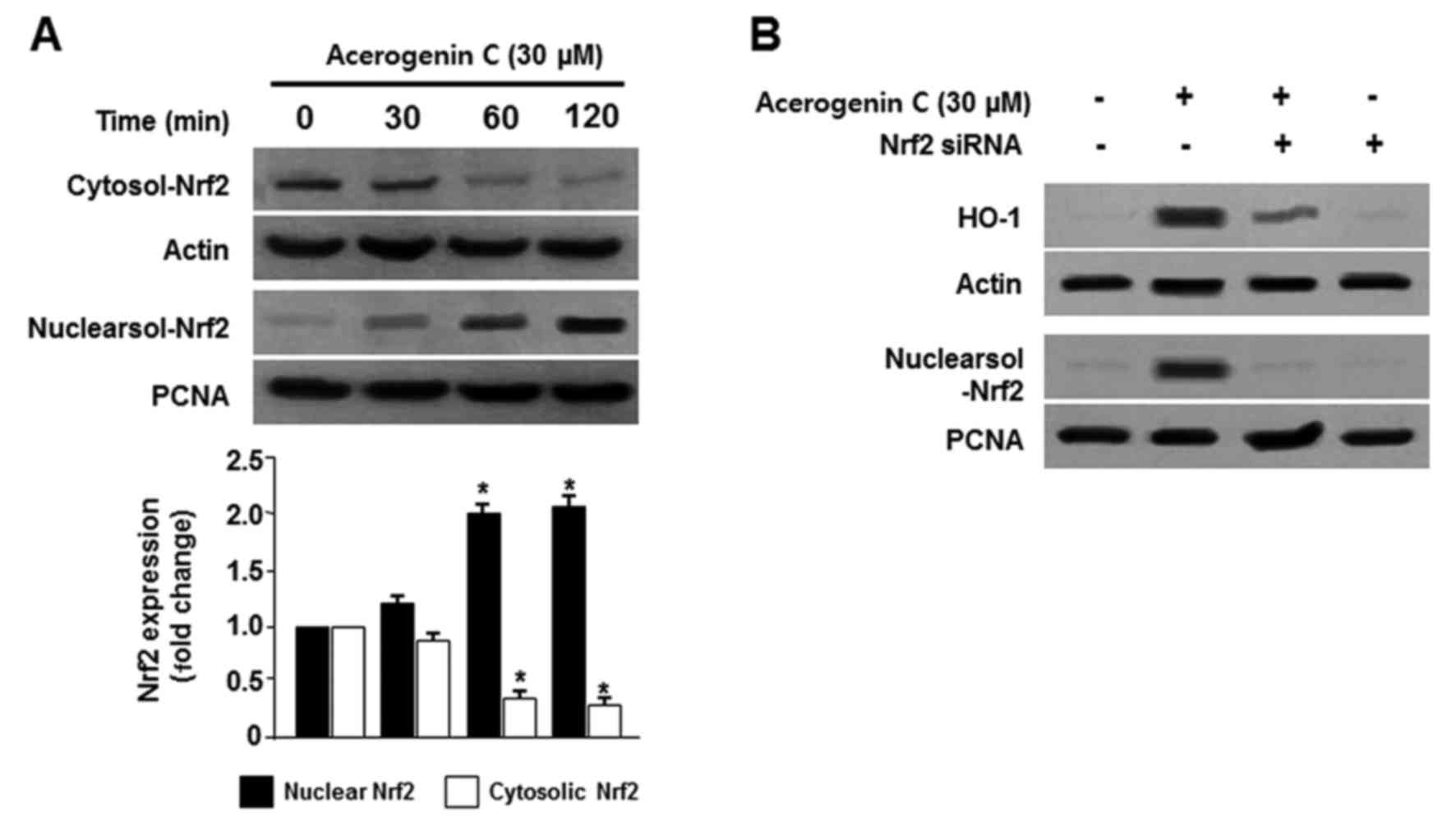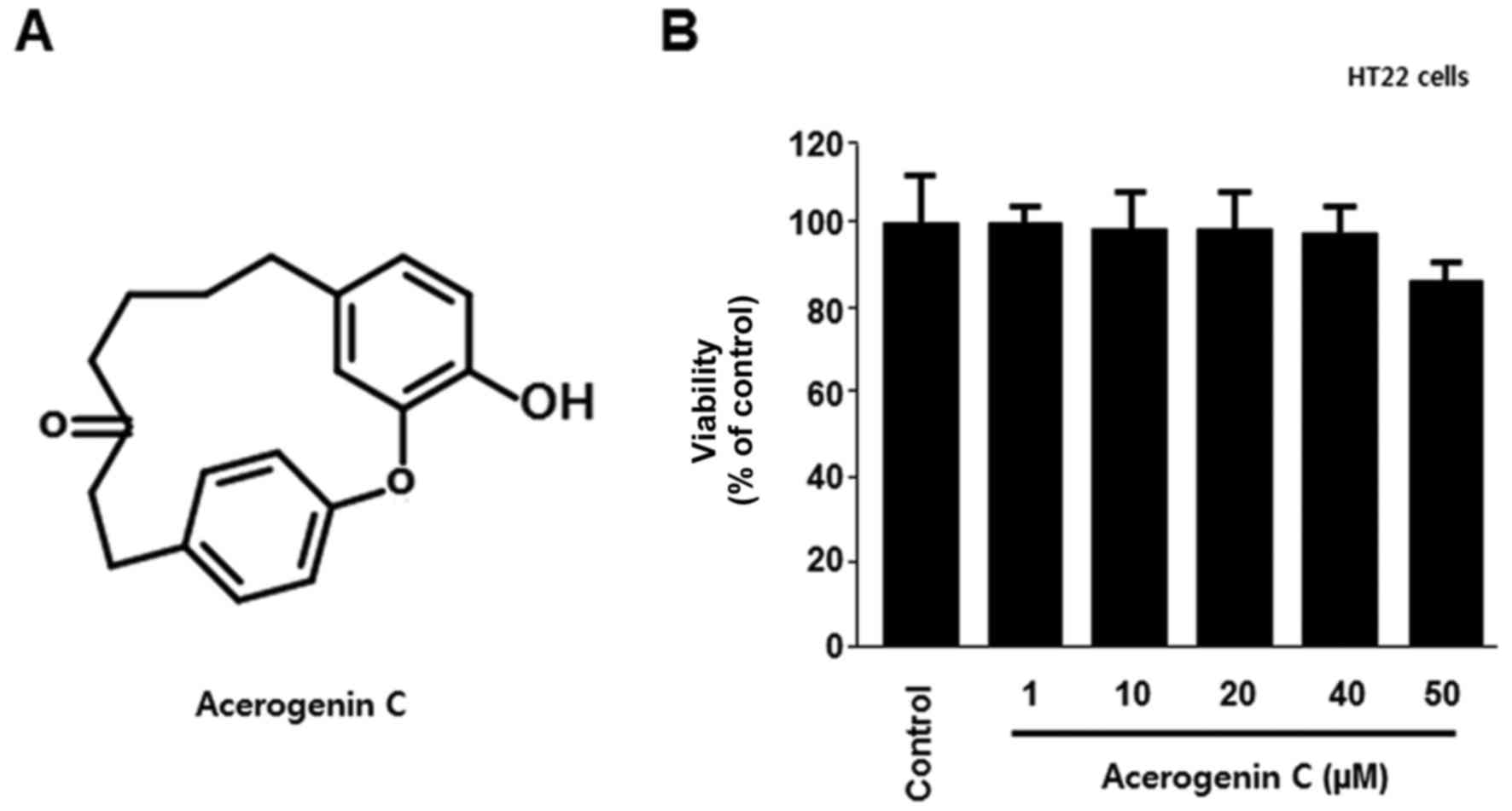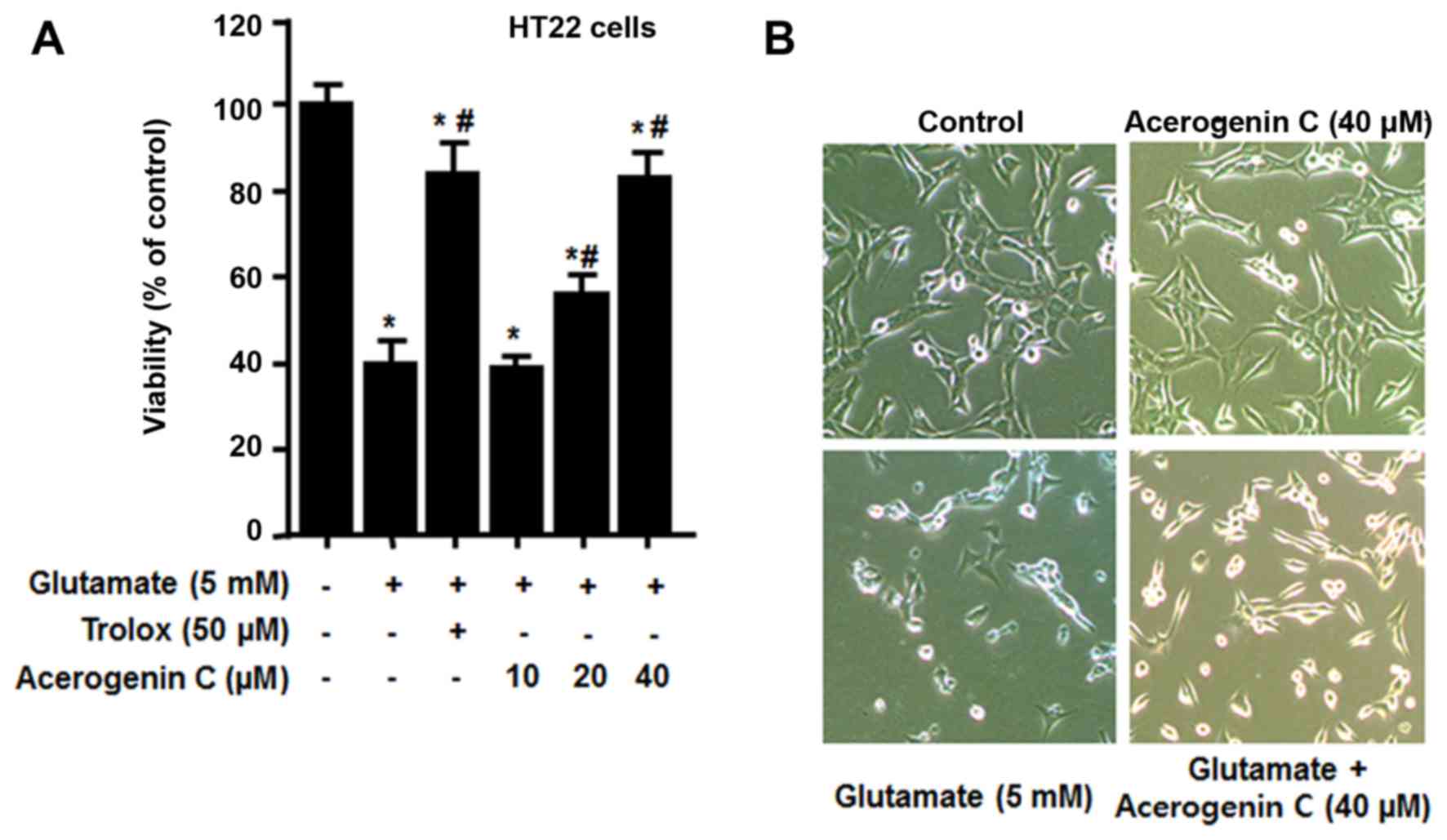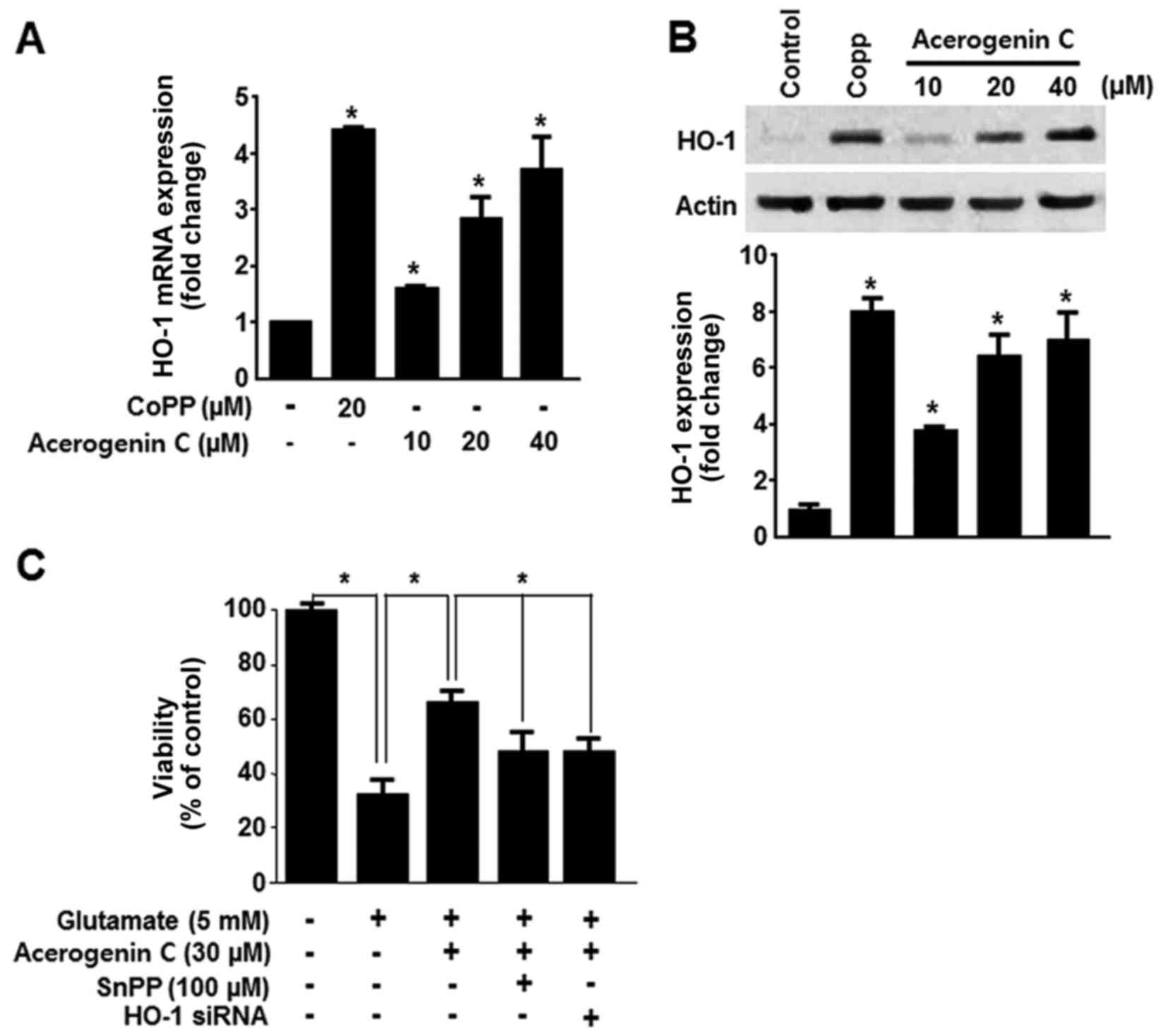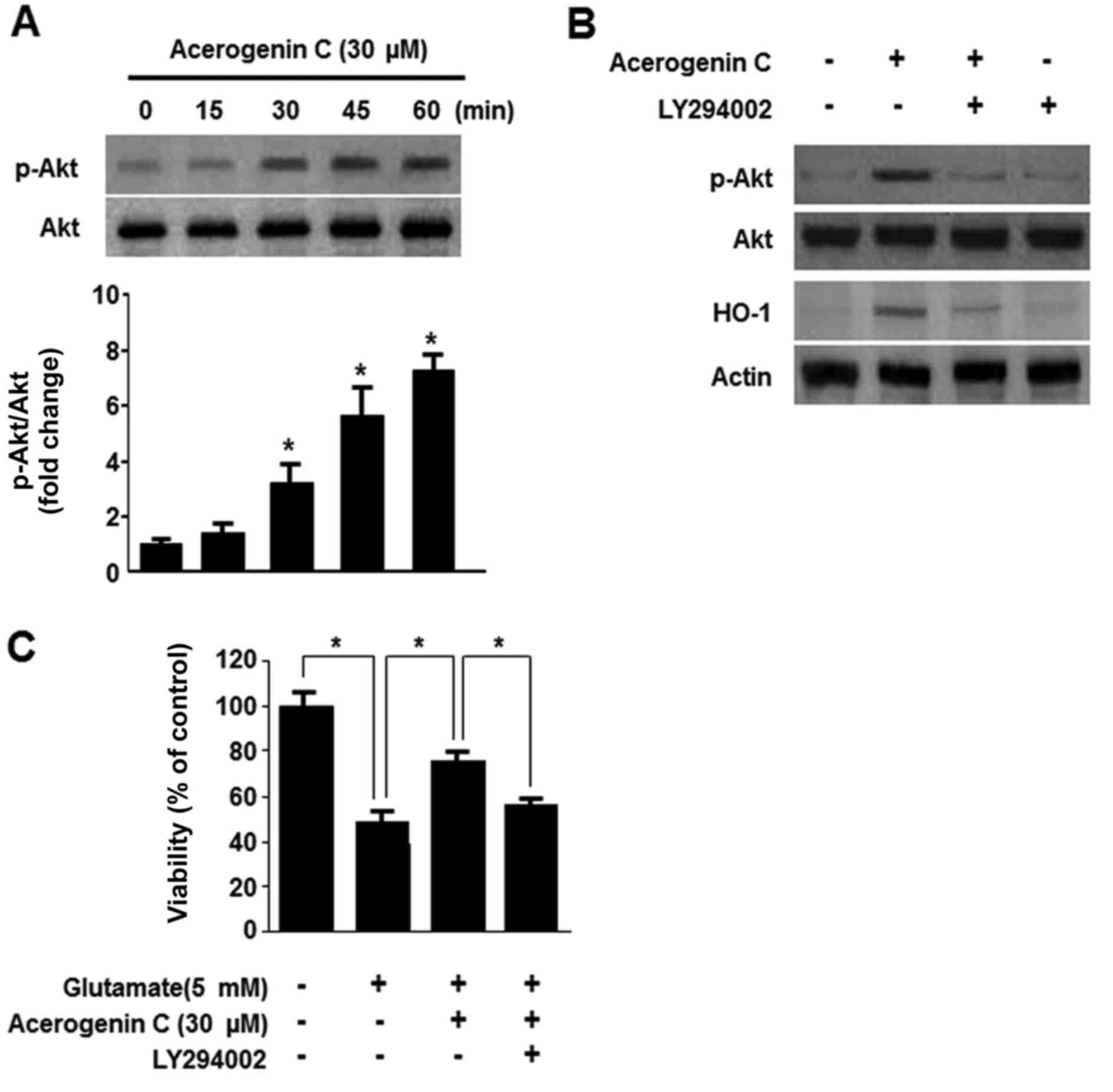Acerogenin C from Acer nikoense exhibits a neuroprotective effect in mouse hippocampal HT22 cell lines through the upregulation of Nrf-2/HO-1 signaling pathways
- Authors:
- Published online on: June 2, 2017 https://doi.org/10.3892/mmr.2017.6682
- Pages: 1537-1543
Abstract
Introduction
Neuronal death in the brain can cause Alzheimer's disease (AD), which is the most common irreparable and progressive neurodegenerative disease. In the human brain, increased oxidative stress associated with reactive oxygen species (ROS) can cause disorders of the central nervous system. In addition, oxidative stress is associated with diverse neurodegenerative diseases resulting in neurodegenerative processes (1,2). The most important ROS, superoxide and hydroxyl radicals, can cause oxidative stress to molecular organisms. Oxidative stress-associated apoptotic action is connected to neuronal cell death and critical neuronal disorders, including ischemia. A well-known neuronal transmitter, glutamate, is unduly released during neuroinflammation (3). The irregular discharge of glutamate into the extracellular area inhibits the cysteine/glutamate antiporter, which transports cysteine into the cytoplasm while removing glutamate from the cells. This subsequently suppresses glutathione biosynthesis and can cause the increases in ROS (4). In addition, nuclear factor erythroid 2-related factor 2 (Nrf2)/antioxidant response element (ARE) serve a key role against cellular oxidative stress (5). Nrf2/ARE also activates downstream signaling through inducible antioxidant enzymes, including heme oxygenase 1 (HO-1) and reduced nicotinamide-adenine dinucleotide phosphate dehydrogenase [quinone] 1 (6). Among these enzymes, HO-1 is recognized to be a protective gene against oxidative stress, which catalyzes the metabolism of heme to yield carbon monoxide, bilirubin/biliverdin and iron (7). HO-1 is a stress-responsive enzyme generated by the stimulation of heat shocks, oxidants and heavy metals. HO-1 serves vital roles in the prevention of oxidative stress and inflammation in cells (8). In HT22 cells, HO-1 exhibits a protective action against glutamate-associated neurotoxicity (9,10).
The Aceraceae plant Acer nikoense (commonly known as Nikko maple or megusurinoki in Japanese) is indigenous to Japan and the stem bark of A. nikoense is used in Japanese folk medicine for the treatment of hepatic sicknesses and eye diseases (11). Furthermore, the stem bark of A. nikoense is ingested as a health food in Japan (12). Various diarylheptanoids and multiple types of phenolic compounds have been identified from the stem bark (13), and tannin, coumarins, lignans, triterpenes, flavonoids and sterols have been characterized in the leaves and wood of A. nikoense (14). In addition, a number of bioactivities in A. nikoense extracts have been reported, including inhibition of the Na+-glucose cotransporter (15), inhibition of nitric oxide production (16), anti-oxidant (17), anti-inflammatory effects (18), hepatoprotective effects (19) and stimulating osteoblast differentiation (20). Acerogenin C was isolated from A. nikoense, and previous studies have determined the estrogenic and antiproliferative activities of acerogenin C (21,22). However, there have been no studies on the mechanisms underlying the antineurodegenerative actions of acerogenin C. In the present study, the neuroprotective effects of acerogenin C on glutamate-stimulated toxicity in HT22 mouse hippocampal cells through Nrf2-associated HO-1 expression were investigated.
Materials and methods
Chemicals and reagents
Acerogenin C was isolated from A. nikoense as previously described (10). All cell culture-associated reagents were obtained from Gibco (Thermo Fisher Scientific, Inc., Waltham, MA, USA). Lipofectamine 2000™ was obtained from Invitrogen (Thermo Fisher Scientific, Inc.). The anti-HO-1 (catalog no. sc-10789), Nrf-2 (catalog no. sc-722), p-Akt (catalog no. sc-514032), Akt (catalog no. sc-5298), proliferating cell nuclear antigen (PCNA; catalog no. sc-56) and β-actin (catalog no. sc-1616) antibodies, and small interfering RNA (siRNA) were obtained from Santa Cruz Biotechnology, Inc. (Dallas, TX, USA). The HO-1 inducer cobalt protoporphyrin IX (CoPP) and all other chemical reagents were purchased from Sigma-Aldrich; Merck KGaA (Darmstadt, Germany).
HT22 cell culture
Mouse hippocampal HT22 cells were donated from Professor Youn-Chul Kim (Wonkwang University, Iksan, Korea). The cells (5×106 cells/dish) were cultured in Dulbecco's modified Eagle's medium containing streptomycin (100 µg/ml), 10% fetal bovine serum (FBS), and penicillin G (100 U/ml) at 37°C in an atmosphere containing 5% CO2 and 95% air.
HT22 cell viability assays
HT22 cells were maintained at 2×104 cells/well and treated with acerogenin C (1, 10, 20, 40 and 50 µM) for 48 h. Alternatively, HT22 cells were pretreated with acerogenin C (10, 20 and 40 µM) or trolox (50 µM) for 12 h, and then treated with glutamate (5 mM) for 12 h. In addition, HT22 cells were treated with acerogenin C (30 µM) in the presence or absence of 50 µM tin protoporphyrin XI (SnPP), (HO)-1 siRNA, or 10 µM LY294002, and then exposed to glutamate (5 mM) for 12 h. All incubations were performed at 37°C and 5% CO2. Following incubation, the cell culture medium was removed from each well and replaced with fresh medium. Cells were incubated with 0.5 mg/ml MTT for 1 h and the formed formazan crystals were dissolved in 150 µl 99.7% dimethyl sulfoxide. Optical density was measured at a wavelength of 590 nm on a microplate reader (Bio-Rad, Hercules, CA, USA).
Extraction of cytoplasmic and nuclear cells
HT22 cells homogenized in PER-Mammalian Protein Extraction buffer (Pierce; Thermo Fisher Scientific, Inc.) supplemented with 1 mM phenylmethylsulfonyl fluoride and protease inhibitor cocktail I (EMD Millipore, Billerica, MA, USA). Cytoplasmic and nuclear fractions were separated using NE-PER Nuclear and Cytoplasmic Extraction reagents (Pierce; Thermo Fisher Scientific, Inc.).
Western blot analysis
HT22 cells were incubated with acerogenin C (10, 20 and 40 µM) or CoPP (20 µM) for 12 h. Alternatively, HT22 cells were treated with 30 µM of acerogenin C for 0, 30, 60 and 120 min, and transiently transfected with Nrf2 siRNA and then treated with 30 µM acerogenin C for 12 h (Fig. 4B). In addition, HT22 cells were pre-incubated with or without 10 µM LY294002 for 1 h and then incubated in the absence or presence of 30 µM of acerogein C for 60 min (p-AKT) or 12 h (HO)-1. Pelleted HT22 cells were obtained by centrifugation at 200 × g for 3 min at room temperature. Following the washing of cells with PBS, they were lysed using Tris-HCl buffer (20 mM; pH 7.4) supplemented with a protease inhibitor mixture containing chymostatin (1 mg/ml), aprotinin (5 mg/ml), pepstatin A (5 mg/ml) and phenylmethylsulfonyl fluoride (0.1 mM). Equal amounts of protein were resolved using SDS-PAGE and transferred to a Hybond-enhanced chemiluminescence nitrocellulose membrane (Bio-Rad Laboratories, Inc., Hercules, CA, USA). The membrane was blocked with 5% skimmed milk at room temperature for 1 h, and then incubated with anti-HO-1, anti-Nrf2, anti-p-Akt, anti-Akt, anti-PCNA, or anti-β-actin antibodies (all of which were used at a 1:1,000) at 4°C overnight. The membrane was subsequently incubated with horseradish peroxidase-conjugated anti-goat (catalog no. ap106p; 1:1,000), rabbit (catalog no. ap132p; 1:1,000) and mouse (catalog no. ap160p; 1:1,000) secondary antibodies, obtained from EMD Millipore, followed by Enhanced Chemiluminescence (GE Healthcare, Chicago, IL, USA) detection substrate. Secondary antibodies were diluted in 3% skimmed milk in TBST buffer. The bands were quantified by densitometry (ImageJ software version 1.47; National Institutes of Health, Bethesda, MD, USA). Nuclear and cytoplasmic extracts of cells were prepared using NE-PER reagents, as per the manufacturer's protocol (Thermo Fisher Scientific, Inc.).
Transfection
Lipofectamine 2000™ (Invitrogen; Thermo Fisher Scientific, Inc.) containing Opti-MEM without FBS were used to temporarily transfect HT22 cells with 50 nM HO-1 siRNA (catalog no. sc-35554) and Nrf2 siRNA (catalog no. sc-37030) (both from Santa Cruz Biotechnology, Inc.) for 6 h. The cell culture medium was replaced with fresh medium with 10% FBS.
Reverse transcription-quantitative polymerase chain reaction
Total RNA was isolated from the cells using TRIzol reagent (Invitrogen; Thermo Fisher Scientific, Inc.) and quantified spectrophotometrically at 260 nm (ND-1000; Thermo Fisher Scientific, Inc.), Total RNA (1 µg) was reverse-transcribed into cDNA using the High Capacity RNA kit (Applied Biosystems; Thermo Fisher Scientific, Inc.). The obtained cDNA was amplified using the SYBR Premix Ex Taq kit (Takara Biotechnology Co., Ltd., Dalian, China) and a StepOnePlus Real-Time PCR (Applied Biosystems). Reaction mixture contained diethyl pyrocarbonate-treated water, primer, and SYBR-Green PCR Master Mix. The sequences of primer were designed by PrimerQuest (Integrated DNA Technologies, Inc., Coralville, IA, USA). The primer sequences are: HO-1 forward, 5′-CTCTTGGCTGGCTTCCTT-3′ and reverse, 5′-GGCTCCTTCCTCCTTTCC-3′; and GAPDH forward, 5′-ACTTTGGTATCGTGGAAGGACT-3′ and reverse, 5′-GTAGAGGCAGGGATGATGTTCT-3′. The thermal cycling conditions used were as follows: Pre-denaturation at 95°C for 10 min, denaturation at 95°C for 15 sec and annealing at 60°C for 1 min. A total of 40 cycles were performed. The data was analyzed using StepOne software (version 2.3; Applied Biosystems; Thermo Fisher Scientific, Inc.), and the cycle number at the linear amplification threshold (quantification cycle; Cq) was recorded for the endogenous control gene and the target gene. Relative gene expression (target gene expression normalized to the expression of the endogenous control gene) was calculated using the comparative Cq method (2−ΔΔCq) (23).
Statistical analysis
All data were expressed as the mean ± standard deviation from at least three independent experiments. To compare each experimental group, one-way analysis of variance was used followed by the Newman-Keuls post hoc test. Statistical analysis of all data was conducted using GraphPad Prism software (version 3.03; GraphPad Software, Inc., La Jolla, CA, USA). P<0.05 was considered to indicate a statistically significant difference.
Results
Effect of acerogenin C on cytotoxicy induced by glutamate and ROS generation in hippocampal HT22 cells
To verify the cytotoxic effects of acerogenin C (Fig. 1A), its effect on the viability of HT22 cells was analyzed using the MTT assay. There were no significant effects at 1–50 µM acerogenin C; however, the viability notably decreased at 50 µM (Fig. 1B). In addition, the neuroprotective effect of acerogenin C on HT22 cells against glutamate-associated cytotoxicity and ROS generation was investigated. To demonstrate the neuroprotective effect of acerogenin C, HT22 cells pretreated with different concentrations of acerogenin C (10, 20 and 40 µM) for 3 h and 5 mM glutamate for 12 h were subject to an MTT assay. The results demonstrated that the viability of 20 and 40 µM acerogenin C-treated cells was significantly increased compared with untreated cells (Fig. 2). Trolox, well-known for its anti-oxidative effect, was used as a positive control and provided a notable cytoprotective effect at a concentration of 50 µM.
Effect of acerogenin C against cytotoxicy induced by glutamate via HO-1 in hippocampal HT22 cells
HO-1 expression serves a key cytoprotective role in HT22 cells. It catalyzes the oxygen-dependent degradation of heme, producing CO, free iron and bilirubin/biliverdin (7). Consequently, the HO-1 induced protective effect in HT22 cells was investigated. HO-1 mRNA expression was evaluated following treatment with acerogenin C. Cobalt protoporphyrin (CoPP) was used as a positive control. CoPP is a well-known HO-1 inducer. Treatment with cerogenin C increased HO-1 mRNA and protein expression in HT22 cells in a dose-dependent manner (Fig. 3A and B). Subsequently it was demonstrated that tin protoporphyrin XI (SnPP), a known inhibitor of HO-1 expression, and HO-1 siRNA significantly blocked the protective effect of acerogenin C (Fig. 3C). These results suggest that HO-1 contributes to the cytoprotective effect of acerogenin C in HT22 cells.
Effect of acerogenin C on the nuclear translocation of Nrf2 in hippocamppal HT22 cells
The Nrf2/HO-1 pathway is important in the prevention of oxidative stress-induced damage. Under normal conditions, Nrf2 is located within cell cytoplasm. During oxidative stress, Nrf2 is phosphorylated and translocated into the nucleus, and binds to the specific ARE sequences (5,6). Therefore, the translocation of Nrf2 to nuclei in HT22 cells was observed. Cells were treated with acerogenin C for 0, 30, 60 and 120 min, and Nrf2 protein levels were detected by western blotting. Cytosolic Nrf2 levels were decreased; however, nuclear Nrf2 levels were increased following treatment with acerogenin C (Fig. 4A). PNCA is widely used as a control in antibody validation of nuclear protein. In addition, the role of Nrf2 in HO-1 activity was analyzed using Nrf2 siRNA. Hippocampal HT22 cells were temporarily transfected with Nrf2 siRNA and were treated with acerogenin C to induce HO-1 activity. Nrf2 siRNA inhibited the nuclear translocation of Nrf2 and transient transfections with Nrf2 siRNA also eliminated the induction of HO-1 expression by acerogenin C (Fig. 4B). These results demonstrated that HO-1 induction by acerogenin C is associated with the Nrf2 nuclear translocation pathway in HT22 cells.
Effect of acerogenin C on the phosphoinositide 3-kinase (PI3K)/protein kinase B (Akt) pathway in the induction of HO-1 expression
Multiple studies demonstrated that the PI3K/Akt pathway is associated with the expression of HO-1 (24). Therefore, it was investigated whether acerogenin C induces expression of HO-1 via the PI3K/Akt signaling pathway. Following treatment with 40 µM acerogenin C, the levels of Akt were significantly increased (Fig. 5A). In addition, treatment with LY294002, a known inhibitor of PI3K, abolishes HO-1 expression and cytoprotection by acerogenin C (Fig. 5B and C). Therefore, acerogenin C-induced HO-1 expression is associated with the PI3K/Akt signaling pathway in HT22 cells.
Discussion
Since the beginning of medicine, humans have depended on chemical compounds taken from animals, plants and micro-organisms to cure diseases. These are referred to ‘natural products’. Natural products have been the most useful sources of lead compounds in the development of drugs. The worth of these ‘natural products’ can be measured using three criteria: Their frequency of use in treatment; the number of chemicals of wide structural variety they contain; and the number of diseases they treat or prevent (25). Neurodegeneration is typically caused when the neuron loses its ability to function properly and its structures, and includes neuron damage. These neurodegenerative processes can be the cause of a number of neurodegenerative diseases, including Parkinson's disease, AD and Huntington's disease. In particular, brain tissue is susceptible to oxidative stress as well as inflammation which may occur through physiological or pathological processes (26).
In previous studies, research was focused on the identification of different bioactive natural compounds, which regulate HO-1 specifically, and their molecular impression on neurodegenerative diseases (27,28). The hippocampus has a significant role in the formation of memory and spatial processing, as well as learning and pattern separation. An immortalized mouse hippocampal cell line, HT22, which resembles neuronal cells; however, lacks functional ionotropic glutamate receptors (29). It is well known that high concentrations of glutamate do not activate glutamate receptors in these cells. HT22 cells are thus relevant to the independent study of oxidative glutamate toxicity (30). In the present study, it was established that acerogenin C exhibits neuroprotective action against glutamate-induced cytotoxicity in HT22 cells. Acerogenin C repressed the generation of ROS induced by glutamate and glutamate-induced cell death in HT22 cells. Furthermore, the induction of HO-1 is involved in the cytoprotective effect of acerogenin C against oxidative stress induced by glutamate in HT22 cells (31). Therefore, it was investigated whether acerogenin C stimulated HO-1 expression in a dose-dependent manner and suppressed the generation of ROS induced by glutamate. As a result, the cytoprotective effect of acerogenin C may be arbitrated by the induction of HO-1 expression.
The neuroprotective effect of acerogeninC in HT22 cells against cytotoxicity induced by glutamate was investigated. The results demonstrated that with acerogenin C (10–40 µM) for 12 h suppressed glutamate-induced cell death in a dose-dependent manner. In a previous study, expression of HO-1 appeared to serve important roles in the protection of neuronal cells (7). Therefore, in the present study it was determined whether acerogenin C-induced HO-1 expression. In HT22 cells, acerogenin C increased HO-1 mRNA expression. To corroborate the cytoprotective effect associated with acerogenin C-mediated HO-1 expression, it was investigated whether the effect of acerogenin C-mediated HO-1 expression was reversed by pretreatment with an inhibitor (SnPP) of HO-1. Furthermore, it is well-known that Nrf2 initiates antioxidant protein expression, including HO-1. It was demonstrated that treatment with acerogenin C induces Nrf2 translocation to the nuclei in HT22 cells and an associated decrease in Nrf2. Nrf2 siRNA completely inhibited nuclear translocation. Furthermore, temporary transfection with Nrf2 siRNA inhibited induction of HO-1 expression by acerogenin C in HT22 cells. These results demonstrated that the upregulation of HO-1 caused by treatment with acerogenin C is associated with the Nrf2 nuclear translocation pathway in HT22 cells. In addition, it was investigated whether upstream signaling pathways, including PI3K/Akt, were involved in the regulation of HO-1 protein. Therefore, it was hypothesized that the mechanism by which acerogenin C defends against anti-oxidative injury is mediated by Nrf2.
Nrf2 exhibits neuroprotective effects and serves a key role in phase II detoxification. Nrf2 a cap‘n’collar transcription factor that regulates the production of multiple anti-oxidative enzymes (32,33). Nrf2 exhibits protective action in different organs and tissues, including the brain, heart and liver (34–36). Nrf2 activation attenuates ROS and inhibits glutamate- and H2O2-induced neurotoxicity to protect neuronal cells (6,37). Nrf2 is significantly required for inducible protein expression, including HO-1 expression (38). In the present study, it was demonstrated that acerogenin C initiates Nrf2 translocation into the nucleus and suggested that Nrf2 performs a vital function in the induction of HO-1 by acerogenin C. PI3K/Akt signaling is associated with the regulation of HO-1 via the activation of the Nrf2 signaling pathway (39,40). Stimulation of the PI3K/Akt signaling pathway may be associated with acerogenin C-induced HO-1 expression.
In conclusion, it was demonstrated that glutamate-induced oxidative stress was decreased by acerogenin C. Acerogenin C also exhibits inhibitory effects on ROS production in HT22 cells. Pretreatment with acerogenin C and LY294002 led to decreased HO-1 expression in HT22 cells. Therefore, acerogenin C induced HO-1 expression via the Nrf2 and PI3K/Akt signaling pathways in HT22 cells. In conclusion, the present study indicates that acerogenin C may be a potential candidate in the treatment of different neurodegenerative diseases.
Acknowledgements
The present study was supported by the Basic Science Research Program through the National Research Foundation of Korea funded by the Ministry of Education, Science and Technology (grant no. 2015R1C1A1A02036465).
References
|
Jazwa A and Cuadrado A: Targeting heme oxygenase-1 for neuroprotection and neuroinflammation in neurodegenerative diseases. Curr Drug Targets. 11:1517–1531. 2010. View Article : Google Scholar : PubMed/NCBI | |
|
Mosley RL, Benner EJ, Kadiu I, Thomas M, Boska MD, Hasan K, Laurie C and Gendelman HE: Neuroinflammation, Oxidative Stress and the Pathogenesis of Parkinson's Disease. Clin Neurosci Res. 6:261–281. 2006. View Article : Google Scholar : PubMed/NCBI | |
|
Caceres LG, Aon Bertolino L, Saraceno GE, Zubilete MA Zorrilla, Uran SL, Capani F and Guelman LR: Hippocampal-related memory deficits and histological damage induced by neonatal ionizing radiation exposure. Role of oxidative status. Brain Res. 1312:67–78. 2010. View Article : Google Scholar : PubMed/NCBI | |
|
Conrad M and Sato H: The oxidative stress-inducible cystine/glutamate antiporter, system × (c) (−): Cystine supplier and beyond. Amino Acids. 42:231–246. 2012. View Article : Google Scholar : PubMed/NCBI | |
|
Lim JL, Wilhelmus MM, de Vries HE, Drukarch B, Hoozemans JJ and van Horssen J: Antioxidative defense mechanisms controlled by Nrf2: State-of-the-art and clinical perspectives in neurodegenerative diseases. Arch Toxicol. 88:1773–1786. 2014. View Article : Google Scholar : PubMed/NCBI | |
|
Ouyang Y, Chen Z, Tan M, Liu A, Chen M, Liu J, Pi R and Fang J: Carvedilol, a third-generation β-blocker prevents oxidative stress-induced neuronal death and activates Nrf2/ARE pathway in HT22 cells. Biochem Biophys Res Commun. 441:917–922. 2013. View Article : Google Scholar : PubMed/NCBI | |
|
Haines DD, Lekli I, Teissier P, Bak I and Tosaki A: Role of haeme oxygenase-1 in resolution of oxidative stress-related pathologies: Focus on cardiovascular, lung, neurological and kidney disorders. Acta Physiol (Oxf). 204:487–501. 2012. View Article : Google Scholar : PubMed/NCBI | |
|
Ryter SW, Otterbein LE, Morse D and Choi AM: Heme oxygenase/carbon monoxide signaling pathways: Regulation and functional significance. Mol Cell Biochem 234–235. 249–263. 2002. View Article : Google Scholar | |
|
Kim DC, Cho KH, Ko W, Yoon CS, Sohn JH, Yim JH, Kim YC and Oh H: Anti-inflammatory and cytoprotective effects of TMC-256C1 from marine-derived Fungus Aspergillus sp. SF-6354 via up-regulation of heme oxygenase-1 in murine hippocampal and microglial cell lines. Int J Mol Sci. 17:5292016. View Article : Google Scholar : PubMed/NCBI | |
|
Lee DS, Cha BY, Woo JT, Kim YC and Jang JH: Acerogenin A from Acer nikoense Maxim prevents oxidative stress-induced neuronal cell death through Nrf2-mediated heme oxygenase-1 expression in mouse hippocampal HT22 cell line. Molecules. 20:12545–12557. 2015. View Article : Google Scholar : PubMed/NCBI | |
|
Nagai M, Kubo M, Fujita M, Inoue T and Matsuo M: Studies on the constituents of Aceraceae plants. II. Structure of aceroside I, a glucoside of a novel cyclic diarylheptanoid from Acer nikoense Maxim. Chem Pharm Bull. 26:2805–2810. 1978. View Article : Google Scholar | |
|
Morikawa T, Tao J, Ueda K, Matsuda H and Yoshikawa M: Medicinal foodstuffs. XXXI. Structures of new aromatic constituents and inhibitors of degranulation in RBL-2H3 cells from a Japanese folk medicine, the stem bark of Acer nikoense. Chem Pharm Bull (Tokyo). 51:62–67. 2003. View Article : Google Scholar : PubMed/NCBI | |
|
Inoue T, Ishidate Y, Fujita M, Kubo M, Fukushima M and Nagai M: Studies on the constituents of Aceraceae plants. I. Constituents in the leaves and the stem bark of Acer nikoense Maxim. Yakugaku Zasshi. 98:41–46. 1978.(In Japanese). | |
|
Furukawa N, Nagumo S, Inoue T and Nagai M: Studies on the constituents of aceraceae plants VII. Coumarinolignans from the wood of Acer nikoense. Shoyakugaku Zasshi. 42:163–165. 1988. | |
|
Morita H, Deguchi J, Motegi Y, Sato S, Aoyama C, Takeo J, Shiro M and Hirasawa Y: Cyclic diarylheptanoids as Na+-glucose cotransporter (SGLT) inhibitors from Acer nikoense. Bioorg Med Chem Lett. 20:1070–1074. 2010. View Article : Google Scholar : PubMed/NCBI | |
|
Deguchi J, Motegi Y, Nakata A, Hosoya T and Morita H: Cyclic diarylheptanoids as inhibitors of NO production from Acer nikoense. J Nat Med. 67:234–239. 2013. View Article : Google Scholar : PubMed/NCBI | |
|
Akazawa H, Akihisa T, Taguchi Y, Banno N, Yoneima R and Yasukawa K: Melanogenesis inhibitory and free radical scavenging activities of diarylheptanoids and other phenolic compounds from the bark of Acer nikoense. Biol Pharm Bull. 29:1970–1972. 2006. View Article : Google Scholar : PubMed/NCBI | |
|
Inoue T: Constituents of Acer nikoense and Myrica rubra. On diarylheptanoids. Yakugaku Zasshi. 113:181–197. 1993.(In Japanese). View Article : Google Scholar | |
|
Shinoda M, Ohta S, Kumasaka M, Fujita M, Nagai M and Inoue T: Protective effect of the bark of Acer nikoense on hepatic injury induced by carbon tetrachloride in rats. Shoyakugaku Zasshi. 40:177–181. 1986. | |
|
Kihara T, Ichikawa S, Yonezawa T, Lee JW, Akihisa T, Woo JT, Michi Y, Amagasa T and Yamaguchi A: Acerogenin A, a natural compound isolated from Acer nikoense Maxim, stimulates osteoblast differentiation through bone morphogenetic protein action. Biochem Biophys Res Commun. 406:211–217. 2011. View Article : Google Scholar : PubMed/NCBI | |
|
Cha BY, Wen LS, Kotaro W, Takayuki Y, Toshiaki T, Kiyotake K, Yuichi I, Shigeru N, Kazuo N and Woo JT: Antiproliferative activity of acerogenin C, a macrocyclicdiarylheptanoid, on PDGF-induced human aortic smooth muscle cells proliferation. Sci Res Publ. 6:47–55. 2015. | |
|
Kim JS, Kim HJ, Jung CL, Nam DH, Lim JS, Han MY and Hong YS: Estrogenic activity of acerogenin C isolated from Acer nikoense Maxim. FASEB J. 25:771.102011. | |
|
Litvak KJ and Schmittgen TD: Analysis of relative gene expression data using real-time quantitative PCR and the 2(−Delta Delta C(T)). Methods. 25:402–408. 2001. View Article : Google Scholar : PubMed/NCBI | |
|
Martin D, Rojo AI, Salinas M, Diaz R, Gallardo G, Alam J, De Galarreta CM and Cuadrado A: Regulation of heme oxygenase-1 expression through the phosphatidylinositol 3-kinase/Akt pathway and the Nrf2 transcription factor in response to the antioxidant phytochemical carnosol. J Biol Chem. 279:8919–8929. 2004. View Article : Google Scholar : PubMed/NCBI | |
|
Koehn FE and Carter GT: Rediscovering natural products as a source of new drugs. Discov Med. 5:159–164. 2005.PubMed/NCBI | |
|
Hald A and Lotharius J: Oxidative stress and inflammation in Parkinson's disease: Is there a causal link? Exp Neurol. 193:279–290. 2005. View Article : Google Scholar : PubMed/NCBI | |
|
Lee DS, Jeong GS, Li B, Park H and Kim YC: Anti-inflammatory effects of sulfuretin from Rhus verniciflua Stokes via the induction of heme oxygenase-1 expression in murine macrophages. Int Immunopharmacol. 10:850–858. 2010. View Article : Google Scholar : PubMed/NCBI | |
|
Lee DS and Jeong GS: Arylbenzofuran isolated from Dalbergia odorifera suppresses lipopolysaccharide-induced mouse BV2 microglial cell activation, which protects mouse hippocampal HT22 cells death from neuroinflammation-mediated toxicity. Eur J Pharmacol. 728:1–8. 2014. View Article : Google Scholar : PubMed/NCBI | |
|
Liao G, Li R, Chen X, Zhang W, Du S and Yuan Y: Sodium valproate prevents radiation-induced injury in hippocampal neurons via activation of the Nrf2/HO-1 pathway. Neuroscience. 331:40–51. 2016. View Article : Google Scholar : PubMed/NCBI | |
|
Wang B, Liu H, Yue L, Li X, Zhao L, Yang X, Wang X, Yang Y and Qu Y: Neuroprotective effects of pterostilbene against oxidative stress injury: Involvement of nuclear factor erythroid 2-related factor 2 pathway. Brain Res. 1643:70–79. 2016. View Article : Google Scholar : PubMed/NCBI | |
|
Li B, Jeong GS, Kang DG, Lee HS and Kim YC: Cytoprotective effects of lindenenyl acetate isolated from Lindera strychnifolia on mouse hippocampal HT22 cells. Eur J Pharmacol. 614:58–65. 2009. View Article : Google Scholar : PubMed/NCBI | |
|
Lee DS, Ko W, Kim DC, Kim YC and Jeong GS: Cudarflavone B provides neuroprotection against glutamate-induced mouse hippocampal HT22 cell damage through the Nrf2 and PI3K/Akt signaling pathways. Molecules. 19:10818–10831. 2014. View Article : Google Scholar : PubMed/NCBI | |
|
Wang B, Liu H, Yue L, Li X, Zhao L, Yang X, Wang X, Yang Y and Qu Y: Neuroprotective effects of pterostilbene against oxidative stress injury: Involvement of nuclear factor erythroid 2-related factor 2 pathway. Brain Res. 1643:70–79. 2016. View Article : Google Scholar : PubMed/NCBI | |
|
Sandberg M, Patil J, D'Angelo B, Weber SG and Mallard C: NRF2-regulation in brain health and disease: Implication of cerebral inflammation. Neuropharmacology. 79:298–306. 2014. View Article : Google Scholar : PubMed/NCBI | |
|
Mann GE: Nrf2-mediated redox signalling in vascular health and disease. Free Radic Biol Med. 75 Suppl 1:S12014. View Article : Google Scholar : PubMed/NCBI | |
|
Krajka-Kuźniak V, Paluszczak J and Baer-Dubowska W: Xanthohumol induces phase II enzymes via Nrf2 in human hepatocytes in vitro. Toxicol In Vitro. 27:149–156. 2013. View Article : Google Scholar : PubMed/NCBI | |
|
Saw CL, Guo Y, Yang AY, Paredes-Gonzalez X, Ramirez C, Pung D and Kong AN: The berry constituents quercetin, kaempferol, and pterostilbene synergistically attenuate reactive oxygen species: Involvement of the Nrf2-ARE signaling pathway. Food Chem Toxicol. 72:303–311. 2014. View Article : Google Scholar : PubMed/NCBI | |
|
Oh GS, Pae HO, Lee BS, Kim BN, Kim JM, Kim HR, Jeon SB, Jeon WK, Chae HJ and Chung HT: Hydrogen sulfide inhibits nitric oxide production and nuclear factor-kappaB via heme oxygenase-1 expression in RAW264.7 macrophages stimulated with lipopolysaccharide. Free Radic Biol Med. 41:106–119. 2006. View Article : Google Scholar : PubMed/NCBI | |
|
Alam J, Stewart D, Touchard C, Boinapally S, Choi AM and Cook JL: Nrf2, a Cap'n'Collar transcription factor, regulates induction of the heme oxygenase-1 gene. J Biol Chem. 274:26071–26078. 1999. View Article : Google Scholar : PubMed/NCBI | |
|
Elbirt KK, Whitmarsh AJ, Davis RJ and Bonkovsky HL: Mechanism of sodium arsenite-mediated induction of heme oxygenase-1 in hepatoma cells. Role of mitogen-activated protein kinases. J Biol Chem. 273:8922–8931. 1998. View Article : Google Scholar : PubMed/NCBI |



